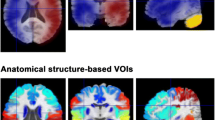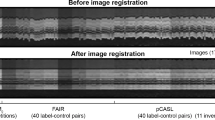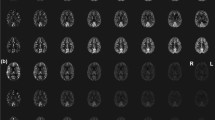Abstract
Object
To propose a new arterial spin labeling (ASL) perfusion-imaging method (alternate slab width inversion recovery ASL: AIRASL) that takes advantage of the qualities of 3.0 T.
Materials and methods
AIRASL utilizes alternate slab width IR pulses for labeling blood to obtain a higher signal-to-noise ratio (SNR). Numerical simulations were used to evaluate perfusion signals. In vivo studies were performed to show the feasibility of AIRASL on five healthy subjects. We performed a statistical analysis of the differences in perfusion SNR measurements between flow-sensitive alternating inversion recovery (FAIR) and AIRASL.
Results
In signal simulation, the signal obtained by AIRASL at 3.0 and 1.5 T was 1.14 and 0.85%, respectively, whereas the signal obtained by FAIR at 3.0 and 1.5 T was 0.57 and 0.47%, respectively. In an in vivo study, the SNR of FAIR (3.0 T) and FAIR (1.5 T) were 1.73 ± 0.49 and 1.02 ± 0.20, respectively, whereas the SNRs of AIRASL (3.0 T) and AIRASL (1.5 T) were 3.93 ± 1.65 and 1.34 ± 0.31, respectively. SNR in AIRASL at 3.0 T was significantly greater than that in FAIR at 3.0 T.
Conclusion
The most significant potential advantage of AIRASL is its high SNR, which takes advantage of the qualities of 3.0 T. This sequence can be easily applied in the clinical setting and will enable ASL to become more relevant for clinical application.







Similar content being viewed by others

References
Chalela JA, Alsop DC, Gonzalez-Atavales JB et al (2000) Magnetic resonance perfusion imaging in acute ischemic stroke using continuous arterial spin labeling. Stroke 31(3):680–687
Chen J, Licht DJ, Smith SE et al (2009) Arterial spin labeling perfusion MRI in pediatric arterial ischemic stroke: initial experiences. J Magn Reson Imaging 29(2):282–290
Garcia DM, Duhamel G, Alsop DC (2004) The efficiency of background suppression in arterial spin labeling. In: Proceedings of the 12th annual meeting of ISMRM, Kyoto, p 1360
Herscovitch P, Raichle ME (1985) What is the correct value for the brain–blood partition coefficient for water? J Cereb Blood Flow Metab 5(1):65–69
Kim MJ, Kim HS, Kim JH et al (2008) Diagnostic accuracy and interobserver variability of pulsed arterial spin labeling for glioma grading. Acta Radiol 49(4):450–457
Kimura H, Kado H, Koshimoto Y et al (2005) Multislice continuous arterial spin-labeled perfusion MRI in patients with chronic occlusive cerebrovascular disease: a correlative study with CO2 PET validation. J Magn Reson Imaging 22(2):189–198
Kimura H, Takeuchi H, Koshimoto Y et al (2006) Perfusion imaging of meningioma by using continuous arterial spin-labeling: comparison with dynamic susceptibility-weighted contrast-enhanced MR images and histopathologic features. AJNR Am J Neuroradiol 27(1):85–93
Moffat BA, Chenevert TL, Hall DE et al (2005) Continuous arterial spin labeling using a train of adiabatic inversion pulses. J Magn Reson Imaging 21(3):290–296
Mildner T, Trampel R, Moller HE et al (2003) Functional perfusion imaging using continuous arterial spin labeling with separate labeling and imaging coils at 3 T. Magn Reson Med 49(5):791–795
Restom K, Behzadi Y, Liu TT (2006) Physiological noise reduction for arterial spin labeling functional MRI. Neuroimage 31(3):1104–1115
St Lawrence KS, Frank JA, Bandettini PA et al (2005) Noise reduction in multi-slice arterial spin tagging imaging. Magn Reson Med 53(3):735–738
Talagala SL, Ye FQ, Ledden PJ et al (2004) Whole-brain 3D perfusion MRI at 3.0T using CASL with a separate labeling coil. Magn Reson Med 52(1):131–140
Wang J, Licht DJ (2006) Pediatric perfusion MR imaging using arterial spin labeling. Neuroimaging Clin N Am 16(3):149–167, ix
Wolf RL, Detre JA (2007) Clinical neuroimaging using arterial spin-labeled perfusion magnetic resonance imaging. Neurotherapeutics 4(3):346–359
Wong EC, Luh WM, Liu TT (2000) Turbo ASL: arterial spin labeling with higher SNR and temporal resolution. Magn Reson Med 44(4):511–515
Ye FQ, Frank JA, Weinberger DR et al (2000) Noise reduction in 3D perfusion imaging by attenuating the static signal in arterial spin tagging (ASSIST). Magn Reson Med 44(1):92–100
Ye FQ, Mattay VS, Jezzard P et al (1997) Correction for vascular artifacts in cerebral blood flow values measured by using arterial spin tagging techniques. Magn Reson Med 37(2):226–235
Calamante F, Williams SR, van Bruggen N et al (1996) A model for quantification of perfusion in pulsed labelling techniques. NMR Biomed 9(2):79–83
Author information
Authors and Affiliations
Corresponding authors
Appendix
Appendix
To derive an expression for the signal difference between control and labeled spins, we begin with the Bloch equation for longitudinal magnetization of brain tissue water corrected for the effects of arterial and venous flow:
Because the perfusion signal is obtained by subtracting two images acquired with arterial spin tagging states but with identical blood flow, the signal from each compartment is defined as the difference in magnetization in i-th interval between the labeled and control scans:
The difference in magnetization of arterial blood between control and labeled states can be expressed as follows:
First, z-magnetization of the 1st period is considered as:
where T 1app is given by
and the inflowing spins in acquisition of the 1st interval are written as follows:
where δ a represents transit time (delay time), and we assume that the label duration (labeling slab width/flow velocity) equals IT. Then, by substituting Eqs. 9, 10, 11 into Eq. 8, we obtain the following:
where \( M_{a}^{0} = \frac{{M_{0} }}{\lambda } \) by substituting this equation into Eq. 12, we obtain the following:
Then, the general solution is as follows:
where M and C 1 represent initial value of z-magnetization and arbitrary constant in the 1st period, respectively.
where S 1(t = 0) equal 0, then:
when we substitute C 1 into the general solution, we obtain the following:
Next, we consider the signal change of z-magnetization in the 2nd interval. If we define the ASL signal with the following equation:
we have to note that the signal is obtained from the opposite subtraction between control and labeled states. Then, we can derive the following equation:
This formula is identical to the Eq. 12. The arterial inflow spins are also inverted in the 2nd period after 180 pulse as follows:
Therefore, from the Eqs. 18 and 19, we can obtain the same differential equation as that seen for the 1st period.
Since the signal of end of the 1st period should be same as the initial signal of the 2nd period, the relationship: S 2(t = IT) = S 1(t = IT) is used.
where C 2 represents the arbitrary constant in the 2nd period.
Therefore,
The signal of the 3rd period can be considered with the same equation used the first period, but with a different start signal, where S 3(t = 2*IT) = S 2(t = 2*IT). Therefore,
where C3 represents the arbitrary constant in the 3rd period.
Finally, we obtained the general solution of the AIRASL signal for i-th period as follows:
If \( \delta_{a} \) = 0 and i = 1, this Eq. 27 is in agreement with the general solution of FAIR in a previous report [18].
Rights and permissions
About this article
Cite this article
Fujiwara, Y., Kimura, H., Miyati, T. et al. MR perfusion imaging by alternate slab width inversion recovery arterial spin labeling (AIRASL): a technique with higher signal-to-noise ratio at 3.0 T. Magn Reson Mater Phy 25, 103–111 (2012). https://doi.org/10.1007/s10334-011-0301-8
Received:
Revised:
Accepted:
Published:
Issue Date:
DOI: https://doi.org/10.1007/s10334-011-0301-8



